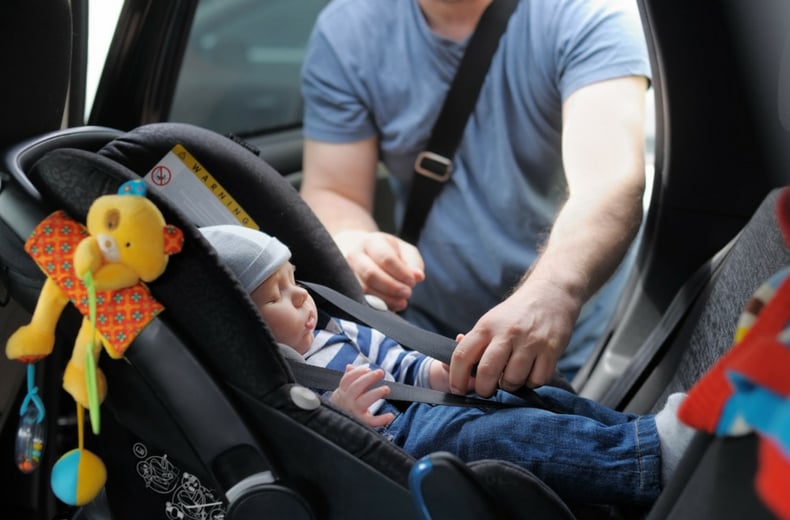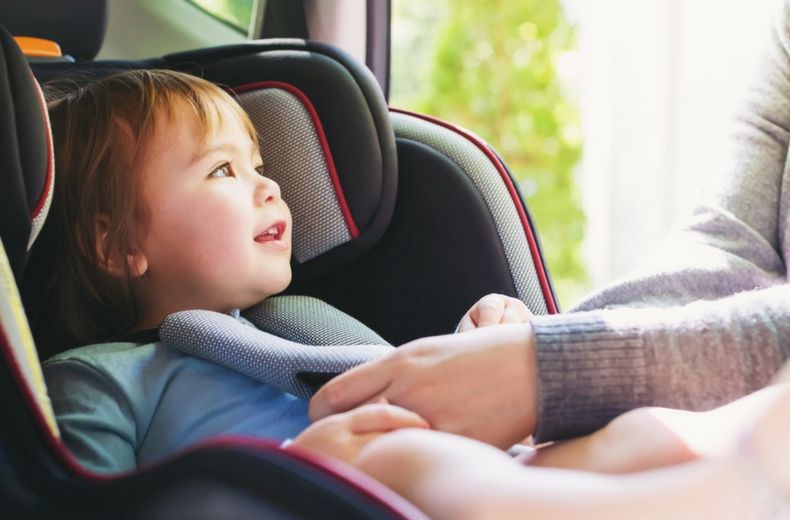Selecting the right child seat will give your little one the best possible protection in the event of a crash, that's why it's important to understand current child car seat laws and the correct way to install one.
It's also important to note that you risk a £500 fine if you’re caught using an unsuitable or incorrectly fitted car seat.
Read the RAC's guide to ensure you keep your child safe and stay on the right side of the law.
UK laws on using child car seats
UK law dictates that a child must use a child car seat until they’re 12-years-old or 135cm tall, whichever comes first. Children over the age of 12 or more than 135cm tall must wear a seat belt.
Since March 2017, all new-to-market backless booster seats are only approved for children weighing more than 22kg or taller than 125cm.
Previously, children who weighed as little as 15kg could use backless booster seats, but concerns over safety resulted in a change in the law.
Only seats approved by the EU are legal in the UK: these will have a label with a capital ‘E’ in a circle and ‘ECE R44’.

SALE – up to 40% off*
Roadside & Recovery from £5.29 a month*
• Cheaper than AA Price Promise or we’ll beat by 20%^
• We get to most breakdowns in 60 mins or less
• Our patrols fix 4/5 breakdowns on the spot

What seat should my child use and when?

You can choose a car seat for your child based either on the child’s height or weight.
- Height-based child seats are called i-Size seats.
- Weight-based child seats offer a range of options: 0kg to 10kg or 13kg, 9kg to 18kg, 15kg to 25kg, and 22kg to 36.
Travelling rear-facing offers the best protection for toddlers and babies. If you use an i-Size child seat, children must be rear-facing seat until they are 15 months old. Never fit a rear-facing child seat in the front if there is an active airbag on the passenger side of the car.
Children weighing more than 22kg or taller than 125cm can use a backless booster seat.
Children of 12 years old or taller than 135cm do not need to use a child seat. Before this age or height they must do by law.
Child seats must be fitted either using ISOFIX mountings or a diagonal seat belt strap.
For smaller children, a highback booster seat is recommended.
Why did the child seat law change in the UK?
Experts warned that backless booster seats are not secure, rendering them unsafe for young children.
In the event of a side-on crash, a standard seat belt offers little protection for a child as it’s not guided across the body in the same way as a booster seat.
Mark Bennett, European Product Expert for Britax, said: "The debate around children’s car seat safety is a perennial topic across Europe, so it isn’t surprising that there are positive updates to the regulations, especially when it comes to booster cushions.
"Booster cushions do not offer head or side protection, which is vital for young children who are still developing and more susceptible to trauma in the event of an accident.
Britax is also urging parents to ‘bin the booster’ and has been for the past years.
Mr Bennet said: "To ensure a child in this size and weight category is protected and safe in transit, the most effective and safe method is to use a highback booster.
"We recommend parents look for highback booster seats with deep protective side wings, head support and seat belt guides to ensure the best protection for their children."
When can kids legally travel without a car seat?
There are some exceptions when a child does not need to legally use a car seat:
- A child can travel in a taxi or minicab without a car seat, but wearing a seat belt, if the driver doesn’t provide the correct child car seat. They must travel in the rear and wear an adult seat belt if they’re over the age of three. Children under three should travel without a seat belt.
- Children can also travel in a coach or minibus without a child car seat, but must travel in the rear seats of a minibus if a child car seat or an adult seat belt isn’t fitted. If child car seats are not fitted or deemed unsuitable, children aged three or older travelling in a minibus must use a seat belt.
- A child aged three or older may also use an adult seat belt if making an unexpected but necessary journey over a short distance.
The same rules apply for children with disabilities or medical conditions, but they may use a disabled person’s seat belt or child restraint designed for their needs. A doctor may issue an exemption certificate if necessary.
However, if you don’t make sure any child passengers have the right car seat, in accordance with the law, and they’re injured or killed in an accident, your car insurance may not cover you. Even if that is temporary car insurance.
- What are the seat belt laws and who's responsible for the passengers?
- Mobile phone driving laws - what is and what isn't illegal
- Road trips with kids - how to survive long journeys with children
- RAC - our work for drivers
What is a booster seat?
Booster seats, as their name suggests, raises your child’s body so they can be suitably secured by a standard, adult seatbelt.
There are two types of booster seat available in the UK:
- Backless booster seats: These do not have a back or headrest to position your child within the car seat and belt
- High-back booster seats: A high-back booster seat has a headrest and back that offers additional support for your child’s head and neck. These are widely considered to be the best booster seat for comfort and safety
What are the laws for booster seats in the UK?
You can legally use a booster seat in the UK, but the rules vary depending on the age of the seat and the weight of your child.
The laws for using a booster seat in the UK are:
- Children must use a child car seat or suitable booster seat until they’re 12 years old or 135 centimetres tall, whichever comes first
- A backless booster seat should only be used by children who are taller than 125cm and weighing more than 22kg
- High-back booster seats can be used by children who weigh between 15-36kg
Older backless booster seats (manufactured before March 2017) can still legally be used by a child weighing 15-36kg but this is not recommended by child seat experts.
What to look for when buying a child car seat
The easiest way to make sure your child is protected (and that you avoid unintentionally breaking the law) is to look for a brand new ‘i-size’ car seat based on the child’s height.
All i-size car seats come with ISOFIX fitting points. This means you can fit the car seat to your car safely without relying on seat-belts. ISOFIX fitting points are increasingly fitted to new cars as standard.
With so many car seats on sale, it can be very confusing choosing the right one for your child. We’d suggest buying one from a high street store. RAC Shop also stocks car seats.
Secondhand seats are often cheap - but you don’t know their history and whether they’ve been involved in a crash which might have damaged them.
All car seats used in the UK must be European-approved. Look out for a label showing a capital ‘E’ in a circle - this indicates that it complies with the latest regulations.
Safety and car seats - the facts
It wasn’t until the 1960s that any real thought was given to child seats – and even then, they were simple booster seats designed to give children a better view out of windows than to keep them safe in the event of a crash.
Volvo has a reputation for being the first with safety advances, so it’s no surprise that it launched a child seat prototype in 1964.
Inspired by how astronauts travel backwards, medical doctor Bertil Aldman (subsequently professor in traffic safety at Chalmers University of Technology), developed the very first child seat prototype and tested it in a Volvo PV544.
The Volvo Amazon was available with a front passenger’s seat that could be turned around entirely from 1967, allowing a child to be kept in place using straps and a padded backrest.
The firm launched the world’s first booster cushion in 1976, and in 1990 the Volvo 960 was launched with an integrated booster cushion.
Seat-belts didn’t become a legal requirement for rear-seat passengers in the UK until 1987 and, remarkably, laws requiring children to use special car seats weren’t introduced until 2006!

Instant cover available
• 24/7 rescue at the roadside
• Help to get home if your vehicle can't be fixed
• 5 star Defaqto rated cover

Get complete peace of mind at home and at the roadside with RAC breakdown cover today.
When you are roadtripping abroad, ensure you get European Breakdown cover.
- Car running costs – a complete guide to help you save money
- How to save fuel – the ultimate guide
- How to save money as a driver – 30 quick money-saving tips
Are you looking for a car seat for your little one? Browse our range of child car seats, over to the RAC Shop.

SALE – up to 40% off*
Roadside & Recovery from £5.29 a month*
• Cheaper than AA Price Promise or we’ll beat by 20%^
• We get to most breakdowns in 60 mins or less
• Our patrols fix 4/5 breakdowns on the spot











